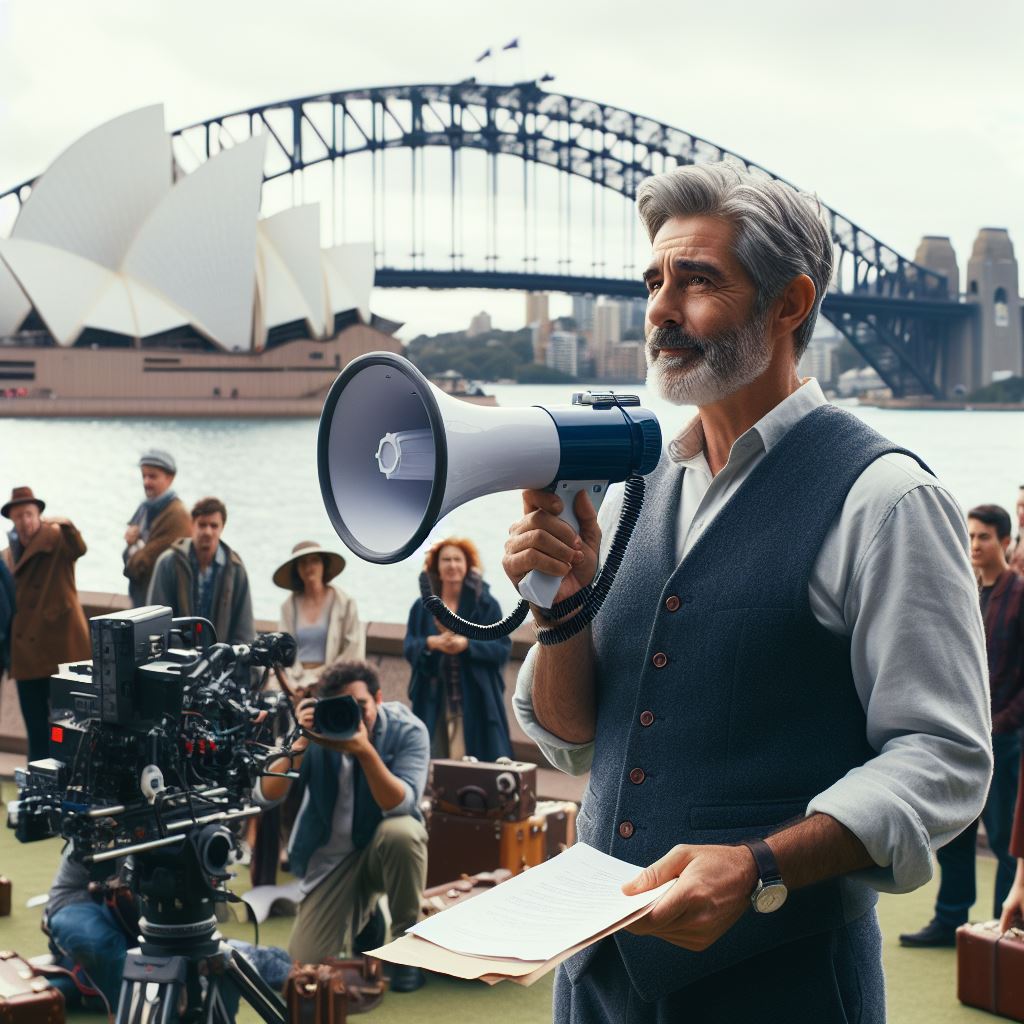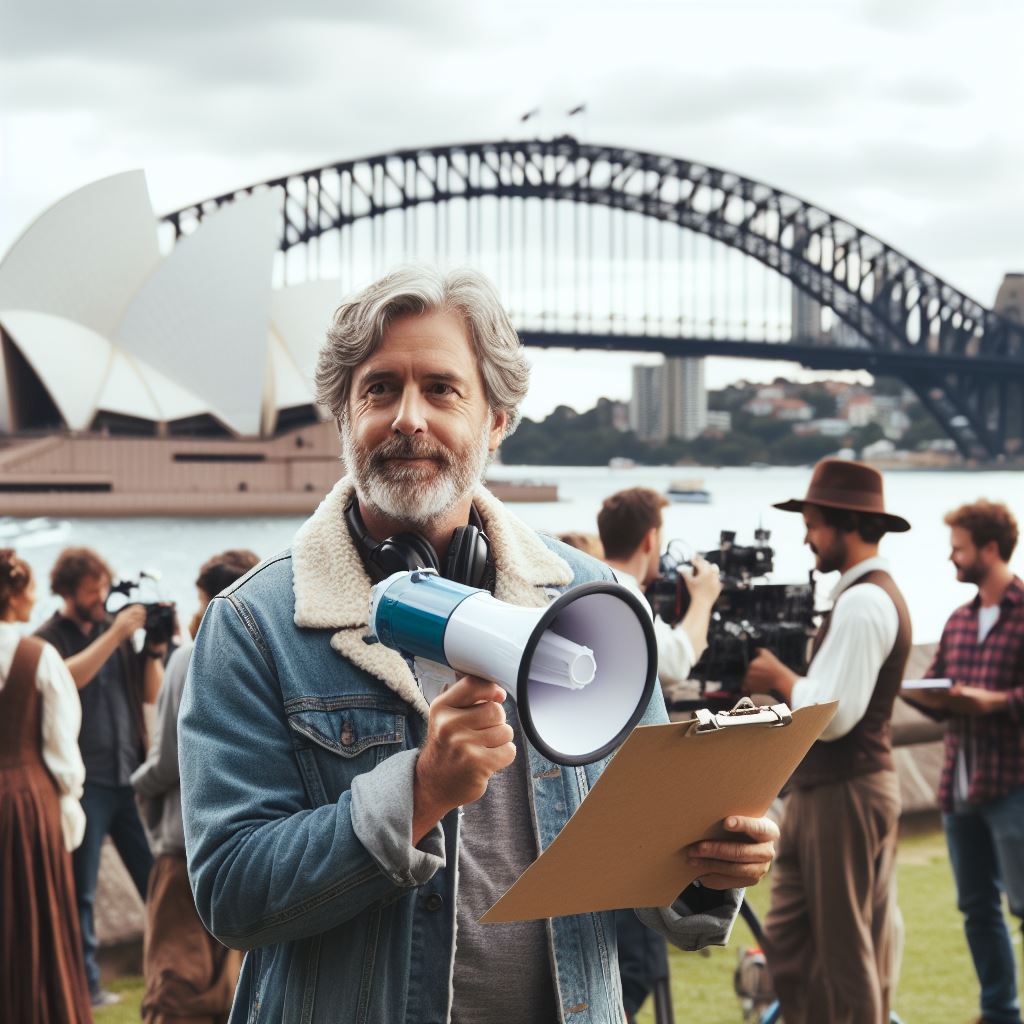Introduction
Directing plays a crucial role in the Australian film industry, shaping the overall vision and narrative of a movie. As the industry continues to evolve, staying updated with emerging trends in directing becomes increasingly important.
In the ever-changing landscape of filmmaking, directors hold the reins, guiding actors, crew members, and the overall production towards a cohesive vision.
They bring scripts to life, overseeing every aspect, from casting to cinematography, editing, and sound design. Without effective directing, films may lack cohesion, fail to engage the audience, or miss important storytelling opportunities.
Staying updated with emerging trends is vital for directors to maintain their relevance and push boundaries. Australian audiences have become more discerning, seeking innovative storytelling techniques and fresh perspectives.
By keeping up with the evolving landscape, directors can create unique film experiences that resonate with contemporary audiences.
The emergence of new technologies, such as virtual reality and augmented reality, has significantly impacted directing. Directors now have the opportunity to explore immersive storytelling, where the audience becomes an integral part of the narrative.
By embracing these emerging trends, directors can create engaging and unforgettable experiences.
Furthermore, staying updated allows directors to tap into the shifting cultural and social dynamics within Australia. By understanding the changing values and perspectives of the audience, directors can better connect with them and address relevant issues.
This not only enhances the quality of films but also establishes a stronger bond between the audience and the industry.
In review, directing plays a vital role in the Australian film industry, and staying updated with emerging trends is essential to remain relevant and meet audience expectations.
By embracing new technologies and understanding societal shifts, directors can continue to create innovative and impactful films.
Increasing Diversity in Australian Directing
The efforts to promote diversity in the directing field
- Australian directing industry has been making significant efforts to promote diversity among filmmakers.
- One of the key goals is to provide equal opportunities for women and minority directors.
- Initiatives like mentoring programs and workshops are being implemented to support diverse talent.
- The industry recognizes the importance of diverse perspectives in storytelling.
- By encouraging more women and minority directors, a wider range of stories can be told.
- Increased diversity in directing leads to more authentic and inclusive representation on screen.
- It challenges traditional narratives and brings fresh ideas to the industry.
- The Australian directing community is actively showcasing the work of female and minority directors.
- The recognition of their talent is inspiring and encouraging others from diverse backgrounds.
- These efforts foster an environment that welcomes and nurtures diverse voices in filmmaking.
Examples of female and minority directors making waves in the industry
- Australian director Niki Caro gained international recognition for her film “Whale Rider” in 2002.
- Jennifer Kent’s directorial debut “The Babadook” received critical acclaim worldwide.
- Warwick Thornton’s films “Samson & Delilah” and “Sweet Country” have garnered numerous awards.
- Australian-Chinese director Clara Law has directed films like “Autumn Moon” and “Goddess of 1967.”
- Rachel Perkins, an Indigenous Australian director, is known for her films “Bran Nue Dae” and “Radiance.”
Impact of diverse perspectives on storytelling and film quality
- Diverse perspectives bring unique cultural insights, enriching the overall storytelling experience.
- Stories told from different backgrounds can challenge stereotypes and promote empathy.
- By including diverse perspectives, filmmakers can create well-rounded and relatable characters.
- These characters resonate with a wider audience, leading to increased engagement and success.
- Diverse directors often bring fresh and innovative approaches to filmmaking, pushing the boundaries of creativity.
- By embracing diversity, the Australian directing industry can foster a vibrant and inclusive film culture.
In essence, the Australian directing industry is actively working towards increasing diversity in the field.
Efforts to promote diversity include mentoring programs, workshops, and highlighting the work of female and minority directors.
By incorporating diverse perspectives, storytelling becomes more authentic, inclusive, and challenging of traditional narratives.
The success and impact of diverse directors demonstrate the importance of their contribution to the industry.
Technological Advancements in Directing
Advancements in technology have completely revolutionized the field of directing, allowing filmmakers to explore innovative techniques that were previously unimaginable.
From drones to virtual reality and CGI, these tools have opened up new creative possibilities and enhanced the director’s ability to tell stories in a visually stunning way.
Let’s delve into how these technological advancements have influenced directing techniques and examine some examples of how Australian directors have utilized them in their work.
Drones
- Drones have provided directors with unprecedented access to aerial shots, revolutionizing the way filmmakers capture landscapes.
- They offer a cost-effective alternative to traditional methods of aerial cinematography, without compromising on visual quality.
- Australian director George Miller effectively utilized drone technology in his critically acclaimed film “Mad Max: Fury Road.”
- The use of drones allowed Miller to capture breathtaking desert landscapes and exhilarating chase sequences.
Virtual Reality
- Virtual reality (VR) has emerged as a groundbreaking tool reshaping the way stories are told and experienced.
- With VR, directors can immerse audiences in fully interactive and immersive environments, blurring the line between reality and fiction.
- Australian director Jennifer Peedom incorporated VR in her documentary “Sherpa” to take viewers on an immersive journey to Mount Everest.
- Through VR, audiences could experience the perilous conditions and breathtaking vistas of the world’s highest peak.
CGI (Computer-Generated Imagery)
- CGI has become an essential tool in modern filmmaking, enabling directors to bring their wildest imaginations to life.
- Australian director James Wan employed advanced CGI techniques in his blockbuster “Aquaman.”
- CGI allowed Wan to create stunning underwater worlds filled with vibrant marine life and epic battle sequences.
- These CGI-enhanced visuals transported audiences to an awe-inspiring underwater kingdom.
These technological advancements in directing have not only enhanced the visual aspects of films but also influenced storytelling methods. Directors now have the ability to transport audiences to unimaginable worlds and create deeply immersive experiences.
As technology continues to evolve, it is exciting to anticipate how directors will push the boundaries of what is possible in filmmaking. The future of directing holds endless possibilities, with new technologies constantly emerging.
Australian directors have demonstrated their proficiency in utilizing these advancements to deliver breathtaking cinematic experiences. They have embraced drones, virtual reality, and CGI to capture stunning visuals and engage audiences on a profound level.
In fact, the advent of drones, virtual reality, and CGI has significantly impacted directing techniques in Australian filmmaking. These advancements have not only expanded the creative options available to directors but also enriched the cinematic experiences for viewers.
The future holds immense potential for further technological advancements and their integration into the art of directing.
Your Personalized Career Strategy
Unlock your potential with tailored career consulting. Get clear, actionable steps designed for your success. Start now!
Get StartedRead: Freelance Journalism in Australia
Collaborative Approaches to Directing
As the landscape of Australian directing continues to evolve, there is a noticeable shift towards more collaborative approaches. Directors are increasingly embracing the power of collaboration to enhance storytelling and create innovative works.
This section explores this emerging trend, providing examples of successful collaborations and highlighting the benefits of such partnerships.
The Shift Toward More Collaborative Approaches
Directing in Australia has traditionally been seen as a solitary role, with directors often being viewed as the sole creative force behind a production.
However, there has been a significant transition in recent years, with directors adopting more collaborative approaches.
This shift can be attributed to various factors, including the recognition that diverse perspectives and expertise can enrich the artistic process.
Directors now understand that by embracing collaboration, they can tap into the unique skills and insights of other creative professionals.
This change in mindset has resulted in a more inclusive and integrated approach to directing, where collaboration is seen as a catalyst for innovation and experimentation.
Examples of Successful Collaborations
There are numerous examples of successful collaborations between directors and other creative professionals in the Australian film and theater industry.
One notable collaboration is between director Baz Luhrmann and production designer Catherine Martin.
Their partnership has produced visually stunning and critically acclaimed films such as “Moulin Rouge!” and “The Great Gatsby.
” Martin’s elaborate set designs perfectly complement Luhrmann’s distinctive directorial style, creating immersive cinematic experiences.
Another example is the collaboration between director Cate Blanchett and playwright Andrew Upton.
Together, they revitalized the Sydney Theatre Company during their tenure as co-artistic directors.
Their joint vision and complementary skills led to the creation of thought-provoking and boundary-pushing productions that captivated audiences and garnered international acclaim.
Benefits of Collaboration in Enhancing Storytelling and Creating Innovative Works
Collaboration brings numerous benefits to the art of directing, particularly in terms of storytelling and the creation of innovative works.
By working collaboratively, directors can tap into a wider pool of ideas and perspectives, resulting in richer and more multidimensional narratives.
Collaborators from different disciplines, such as cinematographers, costume designers, and sound engineers, contribute their unique expertise, elevating the overall quality of the production.
Moreover, collaboration fosters an environment of experimentation and risk-taking.
When directors collaborate with other professionals, they are encouraged to push boundaries and explore new artistic possibilities.
This can lead to the creation of groundbreaking works that challenge conventions and captivate audiences in unexpected ways.
Another advantage of collaboration is the opportunity for directors to learn from their peers and expand their creative horizons.
By working alongside other talented professionals, directors gain new insights and techniques, which can further enhance their own directing skills.
This continuous cycle of learning and growth ultimately benefits the entire industry, fostering a culture of innovation and artistic excellence.
The shift towards more collaborative approaches to directing in Australia reflects a growing recognition of the power of collective creativity.
By embracing collaboration, directors can harness the diverse skills and perspectives of other creative professionals, leading to the creation of innovative and transformative works.
The examples highlighted in this section demonstrate the immense potential of collaboration in enhancing storytelling and pushing the boundaries of artistic expression.
As this trend continues to evolve, it is likely that we will see even more exciting and fruitful collaborations in the Australian directing landscape.
The future of directing relies on the willingness of directors to embrace collaboration and recognize the value of diverse viewpoints and talents.
Through collaboration, directors can unlock new realms of artistic possibility and shape the future of Australian directing.
Read: Digital Era: Aussie Journalists Adapt

Gain More Insights: Voice Acting in Australia: Getting Started
Uncover the Details: Aboriginal Art: Influence & Evolution
Balancing Traditional and Experimental Directing Styles
When it comes to directing, finding a balance between traditional and experimental styles is essential for creating engaging and impactful productions. In Australia, directors are constantly exploring new techniques while also appealing to mainstream audiences.
Importance of Striking a Balance
The art of directing involves making creative choices that bring a script to life and shape the overall vision of a production. While traditional directing styles follow established conventions and techniques, experimental styles push the boundaries and explore new possibilities.
Striking a balance between these two approaches is vital for several reasons. Firstly, it allows directors to maintain a level of familiarity while also injecting fresh and innovative elements into their work.
This balance ensures the production remains accessible to a wide range of viewers while also captivating them with new ideas.
Moreover, finding a balance between traditional and experimental styles enables directors to push their creative boundaries without losing sight of the essence of the story. It ensures that the storytelling remains coherent and meaningful, even in the midst of artistic experimentation.
Impact of Experimentation on Audience Engagement
Experimentation in directing can have a profound impact on audience engagement and reception. By introducing unconventional techniques, directors can challenge the audience’s expectations and create a sense of excitement and anticipation.
When audiences encounter a production that combines traditional and experimental directing styles, they are more likely to be actively engaged. The unexpected elements capture their attention and elicit an emotional response, resulting in a more immersive and memorable experience.
Stand Out with a Resume That Gets Results
Your career is worth more than a generic template. Let us craft a resume and cover letter that showcase your unique strengths and help you secure that dream job.
Get HiredFurthermore, experimentation in directing allows for a deeper exploration of themes and messages within a production.
By breaking away from traditional norms, directors can approach storytelling from unique perspectives, shedding new light on familiar topics and encouraging audiences to think critically.
Australian Directors Pushing Boundaries
Australian directors have been at the forefront of both traditional and experimental directing styles, creating innovative works that resonate with a wide spectrum of audiences.
One notable example is Baz Luhrmann, known for his extravagant and visually stunning films.
His unique blend of theatricality and bold visual choices, as seen in movies like “Moulin Rouge!” and “Australia,” showcases his ability to push boundaries while still appealing to mainstream audiences.
Jennifer Kent strikes a balance between traditional and experimental styles, masterfully combining psychological horror and thought-provoking storytelling in “The Babadook.” Audiences are captivated by its unsettling atmosphere and nuanced performances.
Australian directors aren’t limited to the film industry alone. In the world of theater, Simon Stone has gained international recognition for his modern adaptations of classic plays.
By infusing contemporary elements and innovative staging techniques, he revitalizes well-known stories and captures the attention of diverse audiences.
Directors in Australia understand the importance of striking a balance between traditional and experimental directing styles. It allows them to explore new boundaries while still appealing to mainstream audiences and creating engaging productions.
Experimentation in directing has a significant impact on audience engagement, capturing their attention and eliciting a more immersive experience.
Australian directors like Baz Luhrmann, Jennifer Kent, and Simon Stone showcase their ability to push boundaries while maintaining storytelling coherence.
Ultimately, the fusion of traditional and experimental styles in directing is a testament to the evolving nature of the art form and the creative spirit of Australian directors.
Read: Australian Journalists: Ethics & Challenges
Learn More: Drone Photography: Rules in Australia
Gain More Insights: Breaking into Directing: Tips from Aussie Pros
Uncover the Details: Australian Actor Spotlight: Career Milestones
Discover More: Acting in Australia: Understanding Local Markets
Focus on Authentic Australian Stories
The trend of Australian directors prioritizing local stories and voices
One of the emerging trends in Australian directing is the increased focus on telling authentic Australian stories. Directors are prioritizing local stories and voices, leading to the development of a unique Australian film identity.
Transform Your LinkedIn for Maximum Impact
Elevate your professional brand with a LinkedIn profile that attracts recruiters, showcases your expertise, and maximizes opportunities. Stand out in your industry with a profile built for success.
Boost ProfileThis trend is significant as it allows Australian directors to showcase the diverse culture and experiences unique to their country. By highlighting stories that resonate with Australian audiences, these directors are able to connect with their viewers on a deeper level.
How this trend contributes to the development of a unique Australian film identity
Many successful films have emerged from this trend, reflecting the rich tapestry of Australian stories. One notable example is the critically acclaimed film “The Dressmaker” directed by Jocelyn Moorhouse.
Set in a rural Australian town, the film explores themes of revenge, redemption, and love against the backdrop of the Australian landscape.
Another successful film that embodies this trend is “Lion,” directed by Garth Davis. This emotionally powerful film tells the true story of Saroo Brierley, an Indian-born Australian who sets out to find his birth family.
By incorporating both Indian and Australian cultural elements, the film celebrates the multiculturalism that is a part of Australian society.
Successful films that reflect authentic Australian stories
By focusing on authentic Australian stories, directors are not only highlighting the unique aspects of their country but also contributing to the development of an Australian film identity.
This trend allows Australian cinema to stand out in the global film industry, offering a fresh perspective that is different from Hollywood blockbusters.
Furthermore, the emphasis on local stories and voices helps to nurture and support Australian talent, both in front of and behind the camera.
From emerging actors to established filmmakers, this trend provides opportunities for Australian artists to showcase their skills and make a mark on the industry.
In addition to promoting Australian talent, this trend also fosters a sense of cultural pride and belonging among Australian audiences.
When they see their own stories represented on the big screen, it creates a sense of validation and recognition, deepening their connection to the film and the overall cinematic experience.
Overall, the focus on authentic Australian stories in directing is a positive and essential trend for the Australian film industry.
It contributes to the development of a unique film identity, supports local talent, and fosters a strong sense of cultural pride among Australian audiences.
Through films that reflect the diverse experiences of the country, Australian directors are establishing themselves as important voices in the global film landscape.
Read: The Future of Directing in Australian Cinema
Conclusion
In closing, this blog post has discussed several emerging trends in Australian directing.
We have highlighted the shift towards more diverse stories and the incorporation of technology into filmmaking.
It is crucial for aspiring directors to adapt to these trends and stay updated with the industry.
As the landscape of directing continues to evolve, it is essential for emerging directors to embrace these changes and push the boundaries of their craft.
By staying informed and adapting to new techniques, directors can enhance their storytelling abilities and bring fresh perspectives to their work.
Furthermore, this post encourages readers to explore the works of Australian directors mentioned throughout the blog.
By diving into the films and projects of these directors, readers can gain further insights and inspiration for their own directing journeys.
In the end, the emerging trends discussed in this blog post offer exciting opportunities for Australian directors.
By embracing diversity, technology, and staying up to date with industry changes, aspiring directors can set themselves apart and create impactful and innovative films.
It is an exciting time to be a part of the Australian directing community, and we look forward to witnessing the incredible stories that will emerge from these trends.




